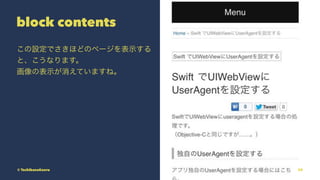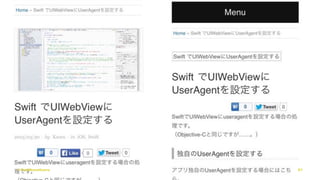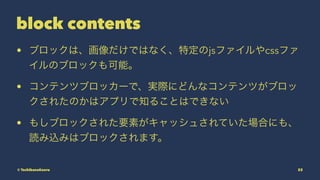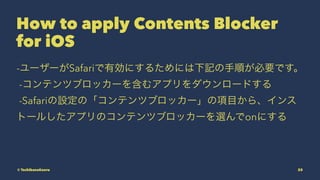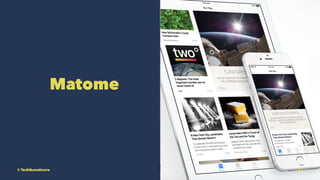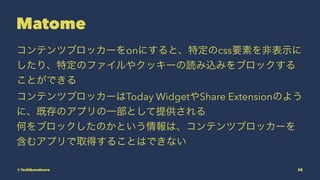Contents blocker on iOS9
- 1. Contents Blocker on iOS9 @TachibanaKaoru ? TachibanaKaoru 1
- 2. ūį╝║ĮBĮķ Tachibana Kaoru - iOS Engineer at VOYAGE GROUP - Twitter: @TachibanaKaoru - Blog: http://www.toyship.org/ ? WWDCżŽ2010,2015ż╦▓╬╝ė ? TachibanaKaoru 2
- 4. What is Contents Blocker ? iOSżõMacżŪSafariż╦▒Ē╩Šż╣żļĒŚ─┐ż“ĪóūįäėĄ─ż╦ųŲŽ▐ż╣żļÖC─▄ ? MacżŪżŽĪóSafari Pluginż╚żĘżŲ╠ß╣®żĄżņżļ ? iOSżŪżŽĪóToday WidgetżõShare Extensionż╬żĶż”ż╦App Extensionż╚żĘżŲ╠ß╣®żĄżņżļ ? TachibanaKaoru 4
- 5. What is Contents Blocker ? źųźĒź├ź»ż╣żļīØŽ¾ ? cssżŪųĖČ©żĄżņż┐╠žČ©ż╬ę¬╦žż“ĘŪ▒Ē╩Šż╦ż╣żļ ? ╠žČ©ż╬źšźĪźżźļż“šiż▀ż│ż▐ż╩żżżĶż”ż╦ż╣żļ ? ╠žČ©ż╬ź»ź├źŁ®`ż“šiż▀ż│ż▐ż╩żżżĶż”ż╦ż╣żļ ? TachibanaKaoru 5
- 6. What is Contents Blocker ? ▀mė├╣Āćņ ? Safarięį═Ōż╬źųźķź”źČŻ©Chromeż╩ż╔Ż®ż╦żŽė░ĒæżĘż╩żż ? iOS9ż½żķī¦╚ļżĄżņż┐ SFSafariViewControllerż╦żŽ▀mė├żĄżņ żļ ? UIWebView/MKWebViewż╦żŽė░ĒæżĘż╩żż ? TachibanaKaoru 6
- 7. How to implement Contents Blocker for iOS ? TachibanaKaoru 7
- 8. How to implement Contents Blocker for iOS iOSżŪżŽź│ź¾źŲź¾ź─źųźĒź├ź½®`żŽĪóApp Extensionż╚żĘżŲ╠ß╣®żĄ żņżŲżżżļż┐żßĪóż▐ż║żŽ▒Š╠Õż╚ż╩żļźóźūźĻż“ū„│╔żĘż▐ż╣ĪŻ XcodeżŪźóźūźĻż“ū„ż├ż┐żķĪóźßź╦źÕ®`ż½żķ File - New - Target ż“▀xżėĪóiOS-Application Extension ż╬ Content Blocker Extension ż“▀xżėż▐ż╣ĪŻ ? TachibanaKaoru 8
- 9. How to implement Contents Blocker for iOS ź│ź¾źŲź¾ź─źųźĒź├ź½®`ż╬ź┐®`ź▓ź├ź╚ż¼ūĘ╝ėżĄżņĪó ActionRequestHandler.swift ż╚ blockerList.json ż╬źšźĪźżźļ ż¼╔·│╔żĄżņż▐ż╣ĪŻ źųźĒź├ź»ż╣żļę¬╦žż╚╠§╝■żŽ blockerList.json źšźĪźżźļżŪįOČ©żĘ ż▐ż╣ĪŻ ? TachibanaKaoru 9
- 11. hide contents CSSż╬╠žČ©ż╬ę¬╦žż“ĘŪ▒Ē╩Šż╦ż╣żļĘĮĘ©żŪż╣ĪŻ blockerList.json ż╦żŽĪóč}╩²ż╬▒Ē╩ŠįOČ©ż“ūĘ╝ėż╣żļż│ż╚ż¼żŪ żŁĪóźšźĪźżźļż╬Ž╚Ņ^ż½żķĒśĘ¼ż╦▀mė├żĄżņżŲżżżŁż▐ż╣ĪŻ actionę¬╦ž äI└Ē─┌╚▌ż╦ż─żżżŲż╬įOČ© triggerę¬╦ž äI└Ēż╬▀mė├╣w╦∙ż╬įOČ© ? TachibanaKaoru 11
- 13. blockerList.json [ { "action": { "type": "css-display-none", "selector" : "div.byline" }, "trigger": { "url-filter": ".*" } } ] ? TachibanaKaoru 13
- 14. hide contents facebookż╬likeź▄ź┐ź¾żŌŽ¹żĘżŲż▀ż▐żĘżńż”ĪŻ ż│ż╬▓┐Ęųż╬divż╬class╩¶ąįżŽwsblfacebooklikeżŪż╣ blockerList.json ż╦ż│ż╬ę¬╦žż“ūĘ╝ėżĘż▐ż╣ ? TachibanaKaoru 14
- 15. blockerList.json [ { "action": { "type": "css-display-none", "selector" : "div.wsbl_facebook_like" }, "trigger": { "url-filter": ".*" } } ] ? TachibanaKaoru 15
- 18. block contents ┤╬żŽĪóź│ź¾źŲź¾ź─ż╬šiż▀▐zż▀ż“źųźĒź├ź»żĘżŲż▀ż▐żĘżńż”ĪŻ ╗ŁŽ±ż╬URLżŽ http://www.toyship.org/wp-content/uploads/ 2014/03/XcodeScreen-636Ī┴310.png żŪż╣ĪŻ blockerList.json ż╦ type:block ż╬actionę¬╦žż“ūĘ╝ėż╣żļż╚Īóż│ ż╬╗ŁŽ±ż╬šiż▀▐zż▀ż“źųźĒź├ź»ż╣żļż│ż╚ż¼żŪżŁż▐ż╣ĪŻ ? TachibanaKaoru 18
- 19. blockerList.json [ { "action": { "type": "block" }, "trigger": { "url-filter": "/wp-content/uploads/2014/03/", "if-domain": ["www.toyship.org"] } } ] ? TachibanaKaoru 19
- 22. block contents ? źųźĒź├ź»żŽĪó╗ŁŽ±ż└ż▒żŪżŽż╩ż»Īó╠žČ©ż╬jsźšźĪźżźļżõcssźšźĪ źżźļż╬źųźĒź├ź»żŌ┐╔─▄ĪŻ ? ź│ź¾źŲź¾ź─źųźĒź├ź½®`żŪĪóīgļHż╦ż╔ż¾ż╩ź│ź¾źŲź¾ź─ż¼źųźĒź├ ź»żĄżņż┐ż╬ż½żŽźóźūźĻżŪų¬żļż│ż╚żŽżŪżŁż╩żż ? żŌżĘźųźĒź├ź»żĄżņż┐ę¬╦žż¼źŁźŃź├źĘźÕżĄżņżŲżżż┐ł÷║Žż╦żŌĪó šiż▀▐zż▀żŽźųźĒź├ź»żĄżņż▐ż╣ĪŻ ? TachibanaKaoru 22
- 24. How to apply Contents Blocker for iOS ? TachibanaKaoru 24
- 25. How to apply Contents Blocker for iOS -źµ®`źČ®`ż¼SafariżŪėąä┐ż╦ż╣żļż┐żßż╦żŽŽ┬ėøż╬╩ųĒśż¼▒žę¬żŪż╣ĪŻ -ź│ź¾źŲź¾ź─źųźĒź├ź½®`ż“║¼żÓźóźūźĻż“ź└ź”ź¾źĒ®`ź╔ż╣żļ -Safariż╬įOČ©ż╬ĪĖź│ź¾źŲź¾ź─źųźĒź├ź½®`Ī╣ż╬ĒŚ─┐ż½żķĪóźżź¾ź╣ ź╚®`źļżĘż┐źóźūźĻż╬ź│ź¾źŲź¾ź─źųźĒź├ź½®`ż“▀xż¾żŪonż╦ż╣żļ ? TachibanaKaoru 25
- 26. Webkit įöżĘżż blockerList.json ż╬įOČ©ĘĮĘ© żŽĪóIntroduction to WebKit Content Blockersż“▓╬ššżĘżŲż»ż└żĄżżĪŻ Benjamin Poulain(@awfulben) ż╩ż¬ĪóźĮ®`ź╣ź│®`ź╔żŌ╣½ķ_żĄżņżŲżżż▐ ż╣ĪŻ ? TachibanaKaoru 26

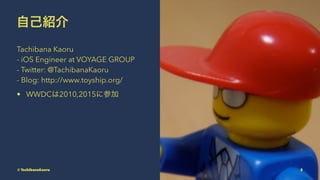

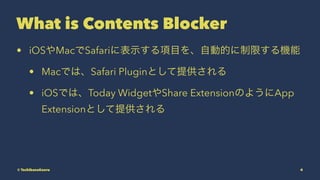


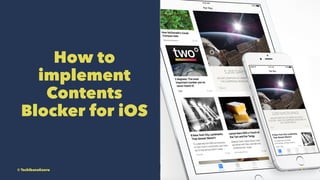
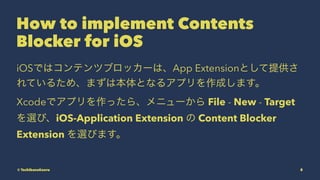
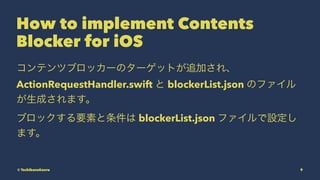
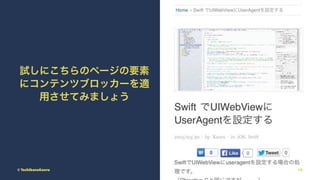

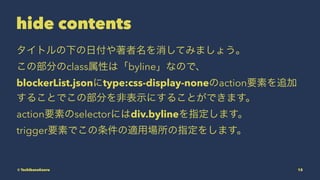
![blockerList.json
[
{
"action": {
"type": "css-display-none",
"selector" : "div.byline"
},
"trigger": {
"url-filter": ".*"
}
}
]
? TachibanaKaoru 13](https://image.slidesharecdn.com/contentsblocker-150619111440-lva1-app6891/85/Contents-blocker-on-iOS9-13-320.jpg)
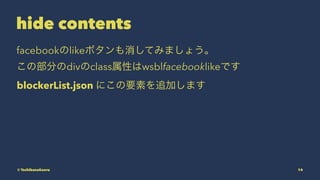
![blockerList.json
[
{
"action": {
"type": "css-display-none",
"selector" : "div.wsbl_facebook_like"
},
"trigger": {
"url-filter": ".*"
}
}
]
? TachibanaKaoru 15](https://image.slidesharecdn.com/contentsblocker-150619111440-lva1-app6891/85/Contents-blocker-on-iOS9-15-320.jpg)

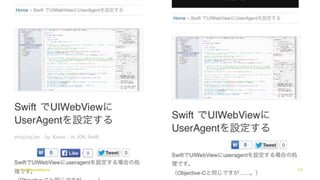
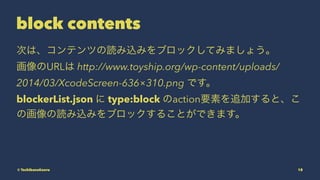
![blockerList.json
[
{
"action": {
"type": "block"
},
"trigger": {
"url-filter": "/wp-content/uploads/2014/03/",
"if-domain": ["www.toyship.org"]
}
}
]
? TachibanaKaoru 19](https://image.slidesharecdn.com/contentsblocker-150619111440-lva1-app6891/85/Contents-blocker-on-iOS9-19-320.jpg)
